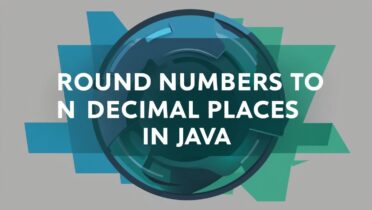Rounding numbers in Java seems simple—until you encounter trailing zeros, incorrect rounding modes, or floating-point inaccuracies. This guide explains three reliable methods to round decimals in Java while avoiding common mistakes.
1. Using DecimalFormat with Explicit Rounding
The DecimalFormat class offers precise control over decimal places and rounding behavior. To round 0.912385 to 5 decimals with half-up rounding (and drop insignificant zeros):
DecimalFormat df = new DecimalFormat("#.#####");
df.setRoundingMode(RoundingMode.HALF_UP);
System.out.println(df.format(0.912385)); // Output: 0.91239
System.out.println(df.format(0.912300)); // Output: 0.9123
#.#####: Format pattern for up to 5 decimals (trailing zeros removed).RoundingMode.HALF_UP: Rounds 0.5 upwards (standard for finance/math).
2. Using BigDecimal for High Precision
For critical applications (e.g., financial calculations), BigDecimal avoids floating-point errors:
double value = 0.912385;
BigDecimal bd = new BigDecimal(String.valueOf(value));
bd = bd.setScale(5, RoundingMode.HALF_UP);
System.out.println(bd.stripTrailingZeros().toPlainString()); // 0.91239
setScale(5, ...): Rounds to 5 decimal places.stripTrailingZeros(): Removes unnecessary zeros (e.g., 0.91230 → 0.9123).
3. The Math.round() Hack (Caution!)
While popular, using Math.round() can introduce errors due to floating-point precision limits:
double value = 0.912385;
double rounded = (double) Math.round(value * 100000) / 100000;
System.out.println(rounded); // 0.91239
⚠️ Pitfalls:
- Fails with numbers like 0.0009434 (due to binary floating-point representation).
- Avoid for mission-critical rounding.
Why Avoid String.format()?
String.format("%.5f", 0.912300) outputs 0.91230 (keeps trailing zeros). Use it only if trailing zeros are acceptable.
Best Practices for Accurate Rounding
- Prefer
BigDecimalfor financial calculations or high-stakes rounding. - Set Rounding Mode Explicitly: Defaults like
HALF_EVEN(bankers’ rounding) may not fit your needs. - Trim Zeros with
DecimalFormatorstripTrailingZeros(). - Avoid Floating-Point Math: Use
Stringconstructors forBigDecimalto prevent precision loss.
Common Mistakes
- Floating-Precision Errors:
System.out.println(0.1 + 0.2); // Output: 0.30000000000000004Fix: UseBigDecimal("0.1")for exact arithmetic. - Ignoring RoundingMode: Forgetting to set it leads to unexpected results.
Performance Considerations
DecimalFormat: Fast for most use cases.BigDecimal: Slightly slower but necessary for precision.Math.round(): Fastest but least reliable.
FAQs
Q: How to round to 2 decimals in Java?
DecimalFormat df = new DecimalFormat("#.##");
df.setRoundingMode(RoundingMode.HALF_UP);
Q: Why does 0.9123 become 0.91230 with String.format?
Use a DecimalFormat pattern with # instead of 0 to suppress trailing zeros.
Q: How to round up always (ceiling)?
Use RoundingMode.CEILING in DecimalFormat or BigDecimal.
Final Thoughts
For reliable decimal rounding in Java, BigDecimal + RoundingMode.HALF_UP is the gold standard. Avoid quick hacks like scaling with Math.round()—they work until they don’t!
(Keywords: Java round decimal places, RoundingMode.HALF_UP, BigDecimal vs DecimalFormat, trailing zeros in Java, floating-point precision errors, Java rounding best practices)
Need precise calculations? Stick with BigDecimal—your future self will thank you! 🔢🚀


